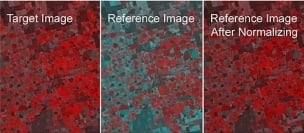Normalizing and Converting Image DC Data Using Scatter Plot Matching
Abstract
:1. Introduction
2. Theory
2.1. Red-NIR Scatter Plot
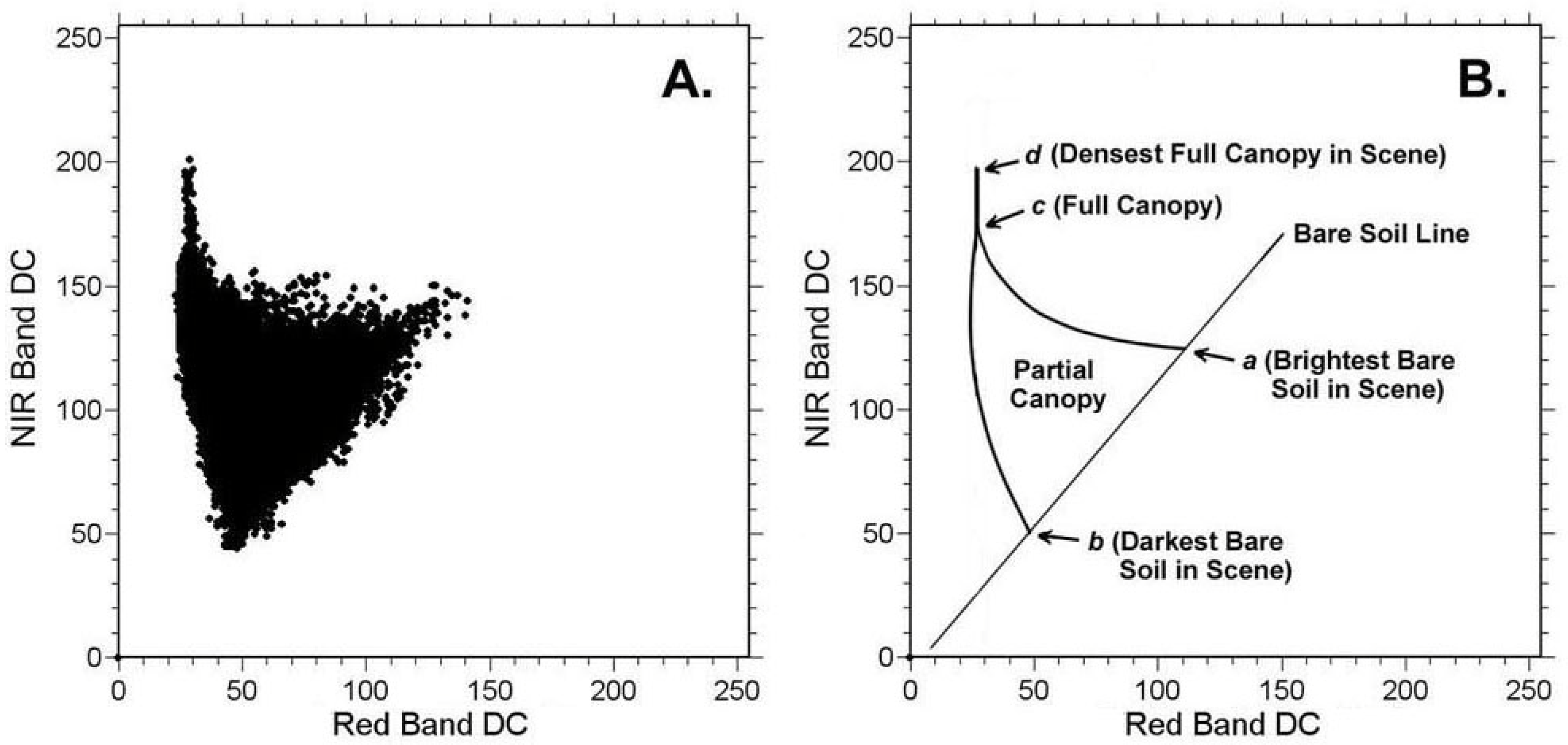
2.2. Transforming Images Using BSL and FCP PIFs
3. Materials and Methods
3.1. Demonstration of Image Normalization
3.2. Conversion of an Image to Reflectance Based on Field Observations
| Symbol | Soil Name | Location Found | Soil Texture | Soil Type | Dry Soil Color | |||
| % sand | % silt | % clay | general | Munsell | ||||
| AM | Amarillo | Lubbock Co., TX | 64 | 16 | 20 | sandy loam | reddish brown | 7.5YR 4/4 |
| HB | Houston Black | Bell Co., TX | 10 | 36 | 54 | clay | black | 2.5Y 4/1 |
| BS | beach sand | South Padre Is., TX | 89 | 2 | 9 | sand | tan | 10YR 7/3 |
| DR | Drake | Hale Co., TX | 74 | 6 | 20 | sandy loam | light gray | 10YR 6/2 |
| PU | Pullman | Hale Co., TX | 48 | 20 | 32 | sandy clay loam | dark brown | 7.5YR 4/3 |
| PA | Paducah | Fisher Co., TX | 62 | 18 | 20 | sandy loam | red | 2.5YR 5/6 |
| WS | gypsum sand | White Sands Nat. Mon., NM | 87 | 2 | 11 | sand | white | 5Y 8/1 |

| Data set | Location | Date | Site | No. of Spectra Measured | Canopy Height (cm) | |
| 1 | pearl millet | Hale Co., TX | August 2008 | farmer’s field | 10 | 80 |
| 2 | alfalfa (set 1) | Hale Co., TX | August 2008 | farmer’s field | 10 | 45 |
| 3 | alfalfa (set 2) | Hale Co., TX | July 2006 | farmer’s field | 12 | 45 |
| 4 | peanut (set 1) | Lubbock Co., TX | August 2008 | research plot | 12 | 25 |
| 5 | peanut (set 2) | Lubbock Co., TX | August 2008 | research plot | 9 | 30 |
| 6 | cotton (set 1) | Lubbock Co., TX | August 2008 | research plot | 11 | 80 |
| 7 | cotton (set 2) | Lubbock Co., TX | August 2008 | research plot | 7 | 100 |
| 8 | cotton (set 3) | Lubbock Co., TX | August 2008 | research plot | 7 | 100 |
| 9 | cotton (set 4) | Hale Co., TX | July 2006 | farmer’s field | 12 | 60 |
| 10 | castor | Lubbock Co., TX | August 2008 | research plot | 11 | 120 |
| 11 | forage sorghum | Hale Co., TX | July 2006 | farmer’s field | 8 | 200 |
| 12 | lawn grass | Lubbock Co., TX | August 2008 | research plot | 8 | 3 |
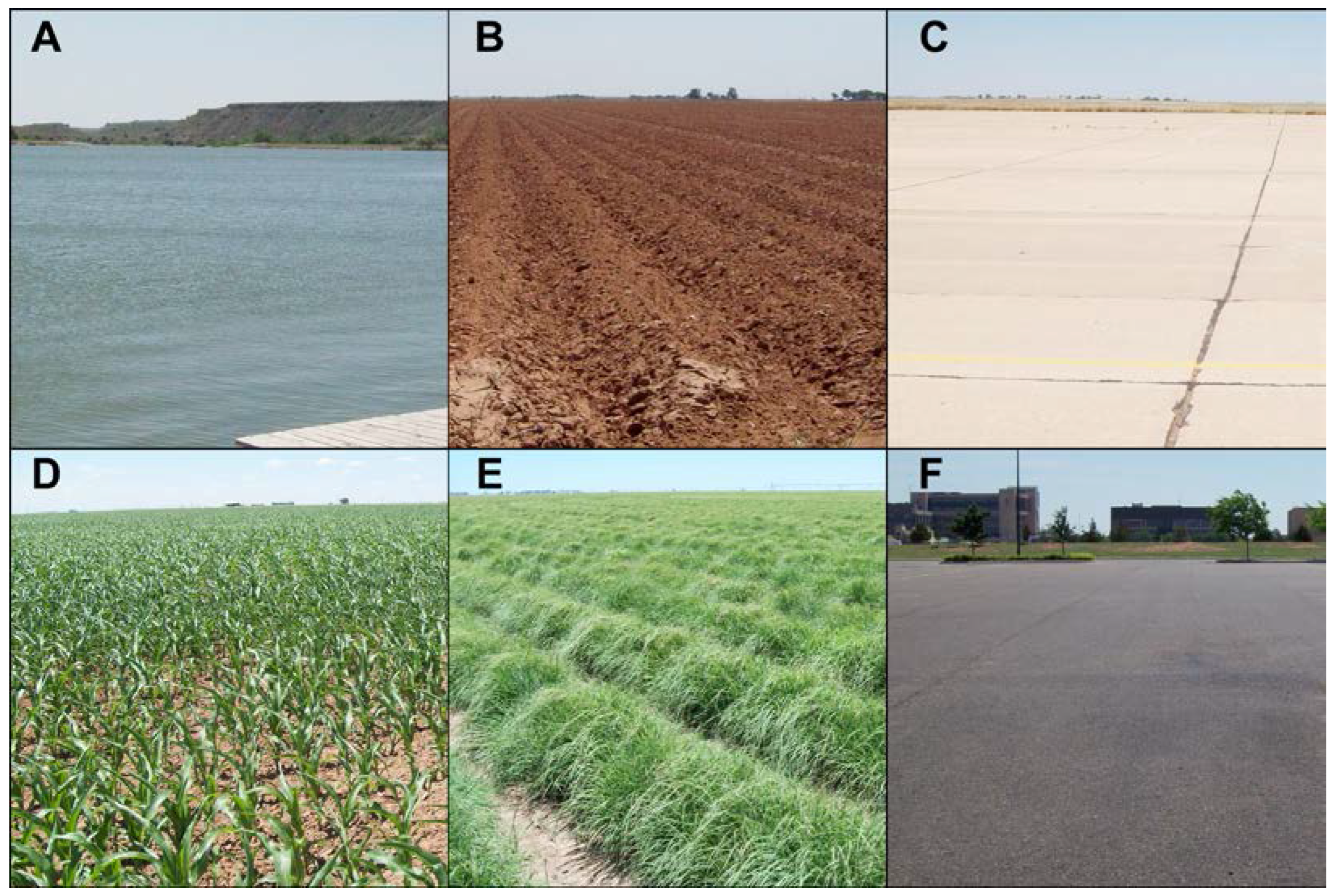
| Site | Location | Date | No. of Spectra Measured | |
| A | Lake Ransom Canyon | Lubbock Co., TX | 13 May | 8 |
| B | Bare soil field | Lubbock Co., TX | 13 May | 8 |
| C | Reese Airbase runway | Lubbock Co., TX | 13 May | 11 |
| D | Corn field (30% GC) | Floyd Co., TX | 29 May | 24 |
| E | Pasture (60% GC) | Floyd Co., TX | 29 May | 48 |
| F | Texas Tech parking lot | Lubbock Co., TX | 13 May | 29 |
4. Results and Discussion
4.1. Image Normalization
4.2. Image Conversion
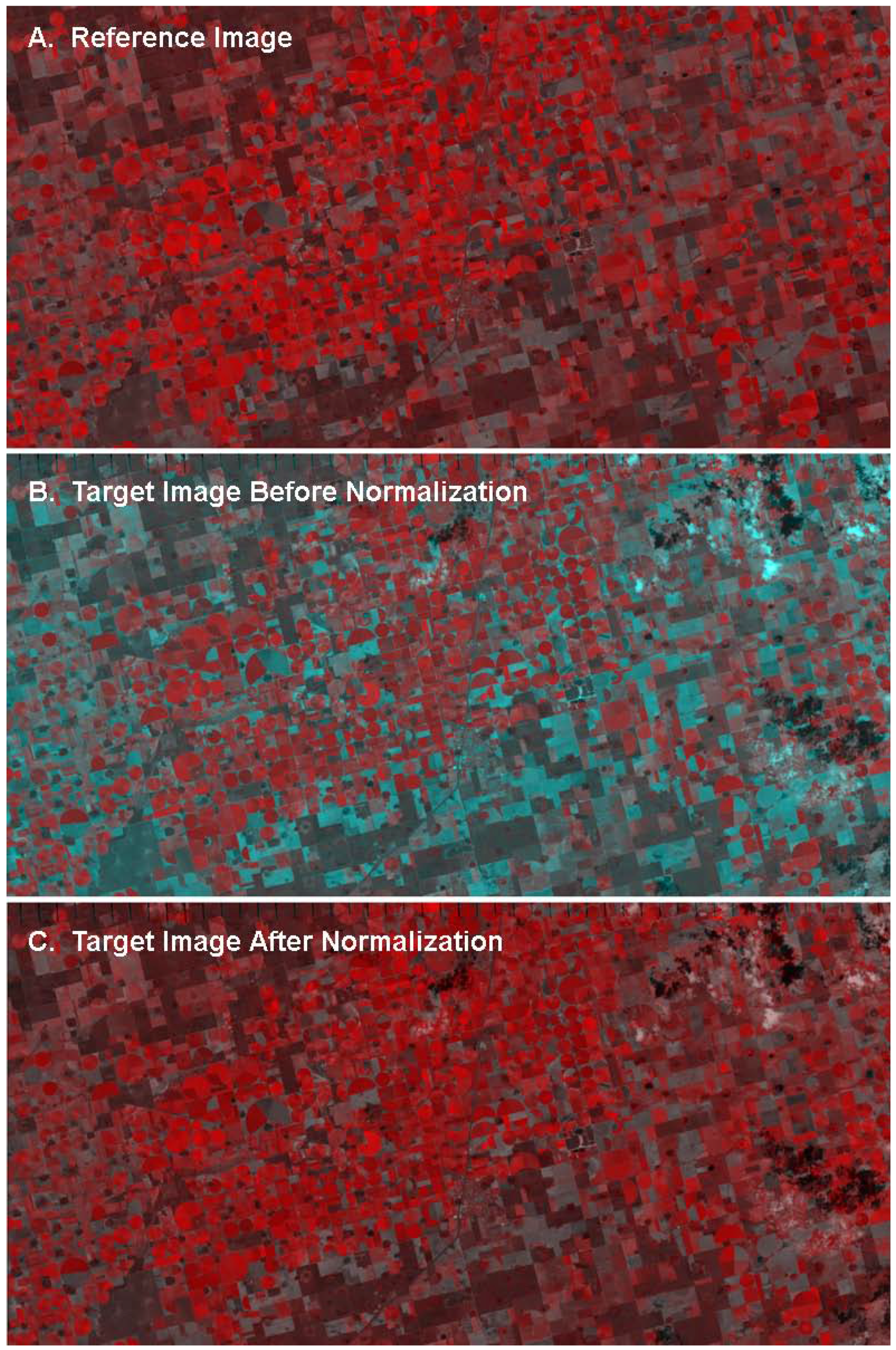
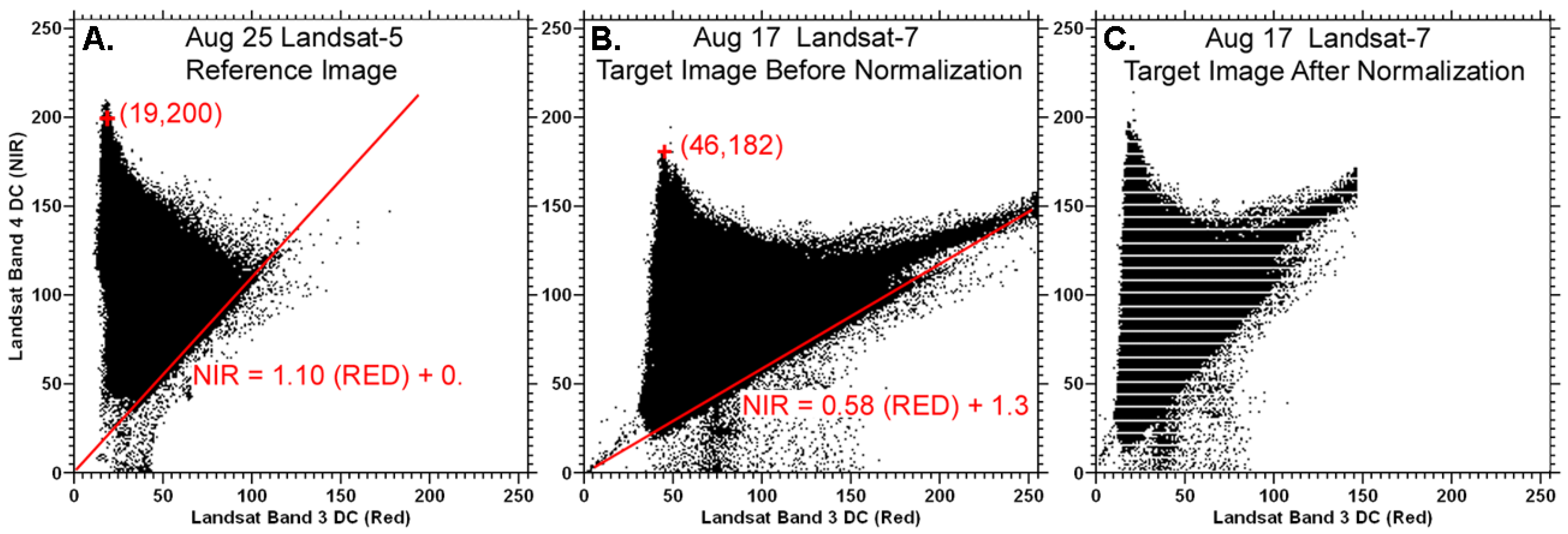
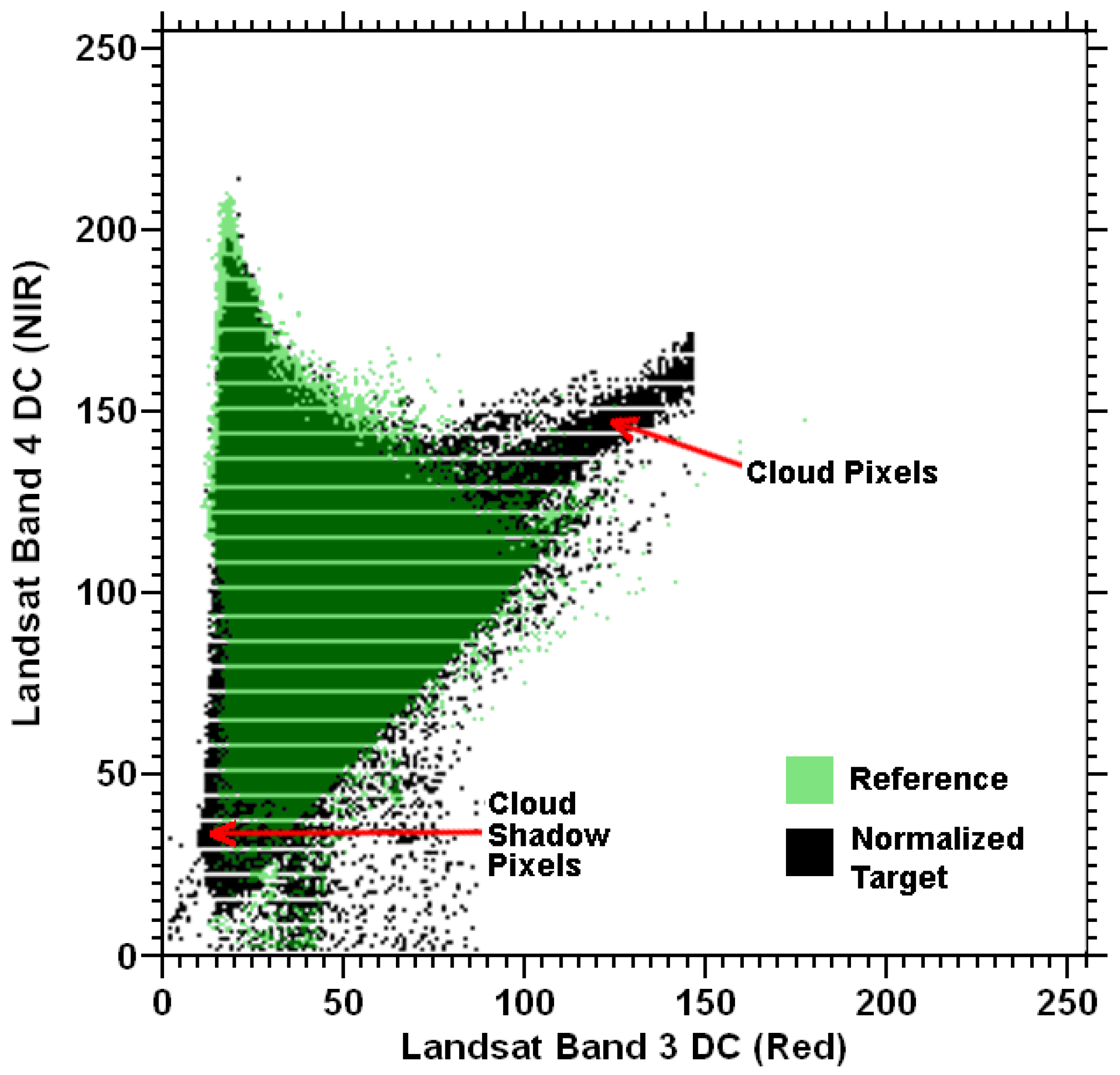
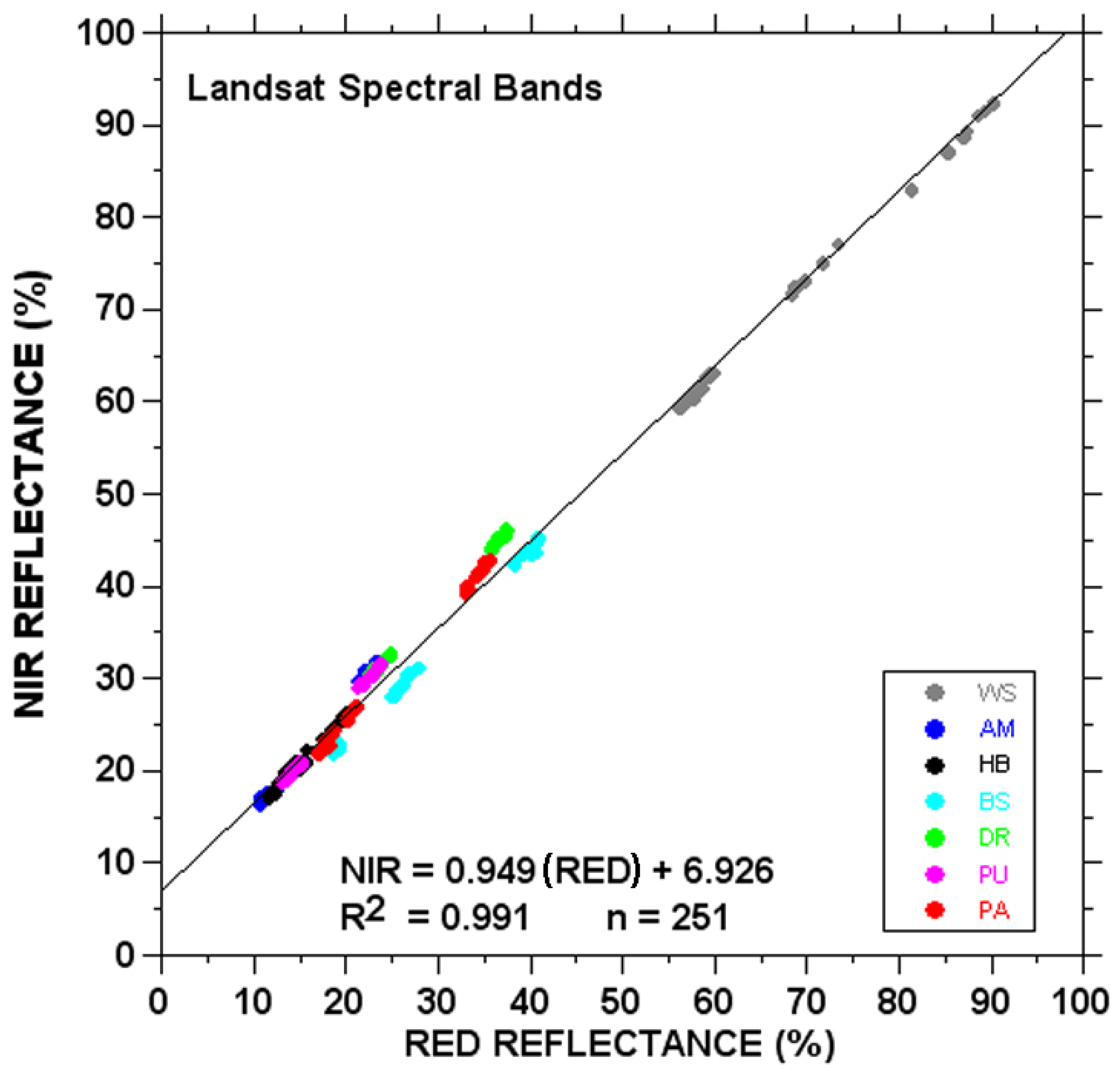

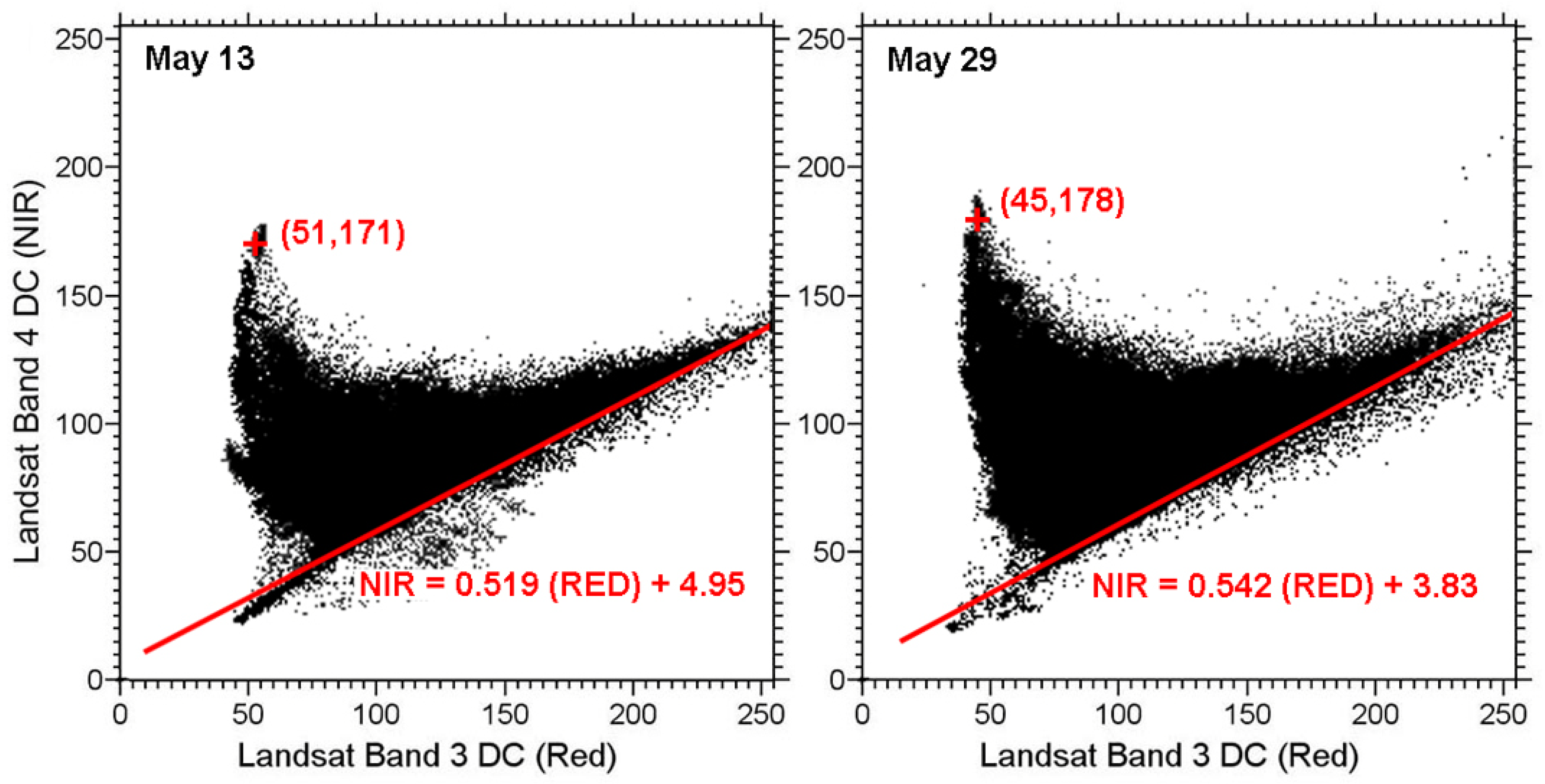
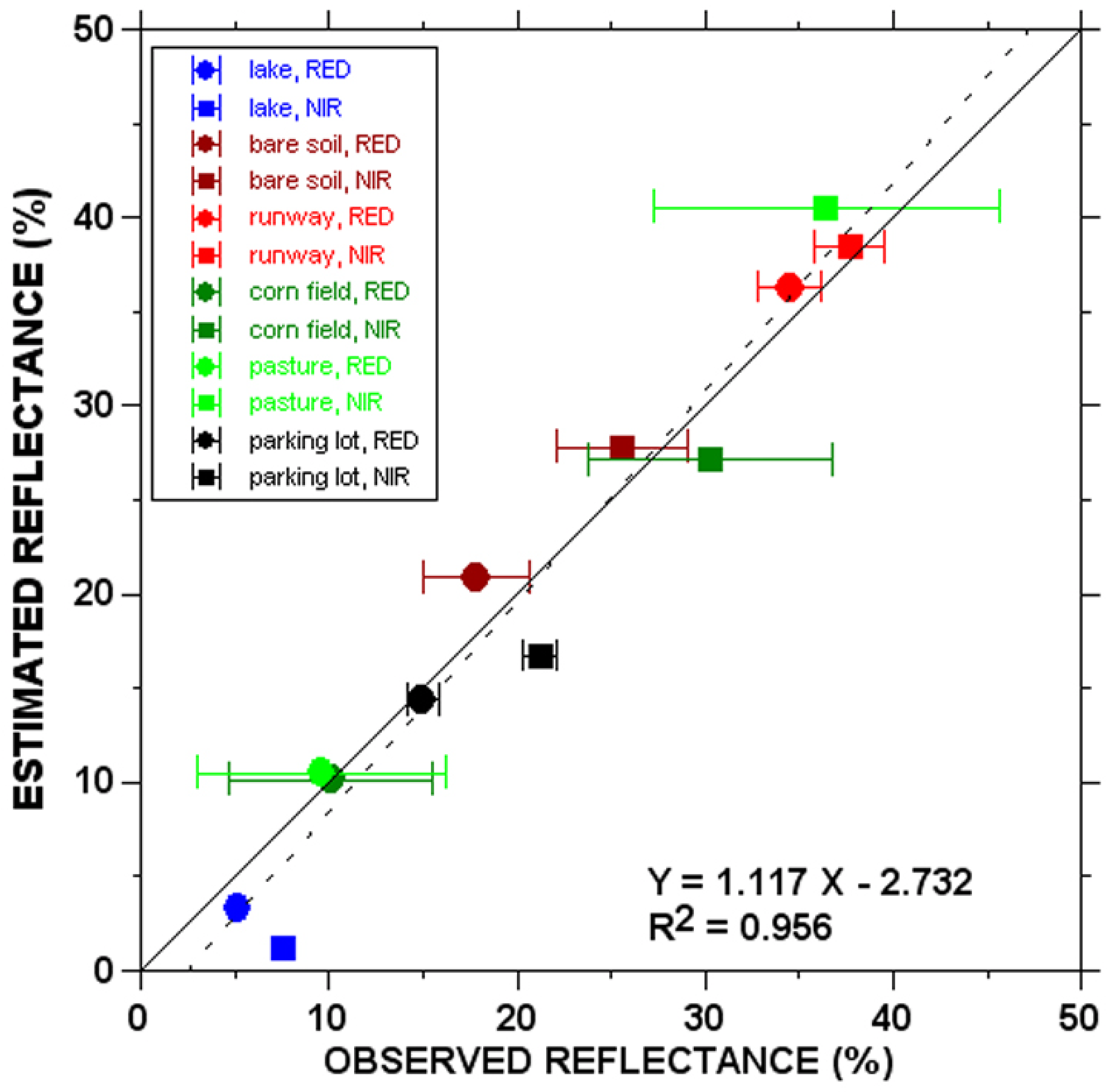
4.2. Strengths and Weaknesses of the SPM Method
5. Conclusions
Acknowledgements
References
- Lu, D.; Mausel, P.; Brondizio, E.; Moran, E. Assessment of atmospheric correction methods for Landsat TM data applicable to Amazon basin LBA research. Int. J. Remote Sens. 2002, 23, 2651–2671. [Google Scholar] [CrossRef]
- Chander, G.; Markham, B. Revised Landsat-5 TM radiometric calibration procedures and postcalibration dynamic ranges. IEEE Trans. Geosci. Remote Sens. 2003, 41, 2674–2677. [Google Scholar] [CrossRef]
- Moran, M.S.; Jackson, R.D.; Slater, P.N.; Teillet, P.M. Evaluation of simplified procedures for retrieval of land surface reflectance factors from satellite sensor output. Remote Sens. Environ. 1992, 41, 169–184. [Google Scholar] [CrossRef]
- Chavez, P.S., Jr. Image-based atmospheric corrections—Revisited and improved. Photogramm. Eng. Remote Sens. 1996, 62, 1025–1036. [Google Scholar]
- Mahiny, A.S.; Turner, B.J. A comparison of four common atmospheric correction methods. Photogramm. Eng. Remote Sens. 2007, 73, 361–368. [Google Scholar] [CrossRef]
- Kruse, A.F. Comparison of ATREM, ACORN, and FLAASH atmospheric corrections using low-altitude AVIRIS data of Boulder, Colorado. In Proceedings of the 13th JPL Airborne Geosciences Workshop, Pasadena, CA, USA, March 31–April 2, 2004.
- Moran, M.S.; Clarke, T.R.; Qi, J.; Barnes, E.M.; Pinter, P.J., Jr. Practical techniques for conversion of airborne imagery to reflectances. In Proceedings of the 16th Biennial Workshop on Videography and Color Photography in Resource Assessment, Weslaco, TX, USA, April 29–May 1, 1997; pp. 82–95.
- Ahern, F.J.; Goodenough, D.G.; Jain, S.C.; Rao, V.R.; Rochon, G. Use of clear lakes as standard reflectors for atmospheric measurements. In Proceedings of the 11th Int. Symposium on Remote Sensing of Environment, Ann Arbor, MI, USA, 1977; pp. 731–755.
- Chavez, P.S., Jr. An improved dark-object subtraction technique for atmospheric scattering correction of multispectral data. Remote Sens. Environ. 1988, 24, 459–479. [Google Scholar] [CrossRef]
- Chavez, P.S., Jr. Radiometric calibration of Landsat Thematic Mapper multispectral images. Photogramm. Eng. Remote Sens. 1989, 55, 1285–1294. [Google Scholar]
- Schott, J.R.; Salvaggio, C.; Volchok, W.J. Radiometric scene normalization using pseudoinvariant features. Remote Sens. Environ. 1988, 26, 1–16. [Google Scholar] [CrossRef]
- Hall, F.G.; Strebel, D.E.; Nickeson, J.E.; Goetz, S.J. Radiometric rectification: Toward a common radiometric response among multidate, multisensory images. Remote Sens. Environ. 1991, 35, 11–27. [Google Scholar] [CrossRef]
- Kauth, R.J.; Thomas, G.S. The Tasseled Cap—A graphic description of the spectral-temporal development of agricultural crops as seen by Landsat. In Proceedings of the Symposium on Machine Processing of Remotely Sensed Data, West Lafayette, IN, USA, June 29–July 1, 1976.
- Jensen, J.R. Remote Sensing of the Environment, an Earth Resource Perspective; Prentice-Hall: Upper Saddle River, NJ, USA, 2000; p. 343. [Google Scholar]
- Liang, S. Quantitative Remote Sensing of Land Surfaces; John Wiley and Sons: New York, NY, USA, 2004; p. 249. [Google Scholar]
- Gausman, H.W. Plant Leaf Optical Properties in Visible and Near-infrared Light; Texas Tech Press: Lubbock, TX, USA, 1985. [Google Scholar]
- Price, J.C. Calibration of satellite radiometers and the comparison of vegetation indices. Remote Sens. Environ. 1987, 21, 15–27. [Google Scholar] [CrossRef]
- USGS/EROS. SLC-off Information. Available online: http://landsat.usgs.gov/products_slc_off_data_information.php (accessed on 22 June 2010).
- Maas, S.J.; Rajan, N. Estimating ground cover of field crops using medium-resolution multispectral satellite imagery. Agron. J. 2008, 100, 320–327. [Google Scholar] [CrossRef]
- Jackson, R.D.; Pinter, P.J., Jr.; Reginato, R.J.; Idso, S.B. Hand-Held Radiometry; Publication ARM-W-19; US Dept. of Agriculture: Phoenix, AZ, USA, 1980. [Google Scholar]
- Huete, A.R.; Post, D.F.; Jackson, R.D. Soil spectral effects on 4-space vegetation discrimination. Remote Sens. Environ. 1984, 15, 155–165. [Google Scholar] [CrossRef]
- Maas, S.J. Structure and reflectance of irrigated cotton leaf canopies. Agron. J. 1997, 89, 54–59. [Google Scholar] [CrossRef]
- Schulthess, Urs. Personal communication, RapidEye AG: Brandenburg, Germany, March 2010.
- Otterman, J.; Ungar, S.; Kaufman, Y.; Podolak, M. Atmospheric effects on radiometric imaging from satellites under low optical thickness conditions. Remote Sens. Environ. 1980, 9, 115–129. [Google Scholar] [CrossRef]
© 2010 by the authors; licensee MDPI, Basel, Switzerland. This article is an open access article distributed under the terms and conditions of the Creative Commons Attribution license (http://creativecommons.org/licenses/by/3.0/).
Share and Cite
Maas, S.J.; Rajan, N. Normalizing and Converting Image DC Data Using Scatter Plot Matching. Remote Sens. 2010, 2, 1644-1661. https://doi.org/10.3390/rs2071644
Maas SJ, Rajan N. Normalizing and Converting Image DC Data Using Scatter Plot Matching. Remote Sensing. 2010; 2(7):1644-1661. https://doi.org/10.3390/rs2071644
Chicago/Turabian StyleMaas, Stephan J., and Nithya Rajan. 2010. "Normalizing and Converting Image DC Data Using Scatter Plot Matching" Remote Sensing 2, no. 7: 1644-1661. https://doi.org/10.3390/rs2071644



